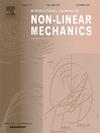Modeling the optimal foam injection slug in porous medium accounting adsorption effects
IF 2.8
3区 工程技术
Q2 MECHANICS
International Journal of Non-Linear Mechanics
Pub Date : 2025-07-05
DOI:10.1016/j.ijnonlinmec.2025.105199
引用次数: 0
Abstract
This study addresses the optimization of surfactant slug design for foam injection in porous media, focusing on applications relevant to carbon capture and storage (CCS) and carbon capture, utilization, and storage (CCUS). We describe the foam flow in a one-dimensional porous medium as a sequence of two Riemann problems, explicitly accounting for surfactant adsorption on the rock surface impacting the surfactant mass available for foam generation. Utilizing the modified implicit texture foam model from the commercial simulator CMG/STARS, we extended previous Riemann problem solutions to include more realistic modeling. Following the classical definition of optimal slug size, we propose a methodology to minimize surfactant usage while maximizing carbon dioxide storage efficiency. The resulting Pareto front offers valuable insights for practical applications. Our key findings indicate a strong dependence of optimal slug properties on adsorption parameters, underscoring the importance of accurately modeling reservoir rock surface — surfactant interactions. Despite employing the linear Henry adsorption isotherm, the identified optimal surfactant concentrations are primarily low, corresponding to the parameter range where this model is physically accurate, supporting our approach. Additionally, Pareto front analysis suggests a methodology to investigate the economic potential of the foam injection. All analytical solutions were validated through direct numerical simulations.
模拟多孔介质中最优泡沫注入段塞,计算吸附效果
本研究针对多孔介质泡沫注入的表面活性剂段塞设计进行了优化,重点研究了与碳捕集与封存(CCS)和碳捕集、利用与封存(CCUS)相关的应用。我们将一维多孔介质中的泡沫流动描述为两个黎曼问题的序列,明确地考虑了表面活性剂在岩石表面的吸附对泡沫生成可用表面活性剂质量的影响。利用商业模拟器CMG/STARS改进的隐式纹理泡沫模型,我们扩展了以前的黎曼问题解决方案,以包括更真实的建模。根据最佳段塞尺寸的经典定义,我们提出了一种最小化表面活性剂使用同时最大化二氧化碳储存效率的方法。由此产生的帕累托前沿为实际应用提供了有价值的见解。我们的主要发现表明,最佳段塞流特性强烈依赖于吸附参数,强调了准确模拟储层岩石表面-表面活性剂相互作用的重要性。尽管采用了线性Henry吸附等温线,但所确定的最佳表面活性剂浓度主要较低,这与该模型在物理上准确的参数范围相对应,支持了我们的方法。此外,帕累托前沿分析提出了一种研究泡沫注入经济潜力的方法。所有解析解均通过直接数值模拟得到验证。
本文章由计算机程序翻译,如有差异,请以英文原文为准。
求助全文
约1分钟内获得全文
求助全文
来源期刊
CiteScore
5.50
自引率
9.40%
发文量
192
审稿时长
67 days
期刊介绍:
The International Journal of Non-Linear Mechanics provides a specific medium for dissemination of high-quality research results in the various areas of theoretical, applied, and experimental mechanics of solids, fluids, structures, and systems where the phenomena are inherently non-linear.
The journal brings together original results in non-linear problems in elasticity, plasticity, dynamics, vibrations, wave-propagation, rheology, fluid-structure interaction systems, stability, biomechanics, micro- and nano-structures, materials, metamaterials, and in other diverse areas.
Papers may be analytical, computational or experimental in nature. Treatments of non-linear differential equations wherein solutions and properties of solutions are emphasized but physical aspects are not adequately relevant, will not be considered for possible publication. Both deterministic and stochastic approaches are fostered. Contributions pertaining to both established and emerging fields are encouraged.

 求助内容:
求助内容: 应助结果提醒方式:
应助结果提醒方式:


